
Fog, smoke, and air inversion often create a perfect setting for bad air quality along the Ohio River near the Shenango Inc. coke works. Residents living nearby have the highest rates of asthma in Allegheny County. Coke oven fuel made from coal emits various toxins along with odors and smoke. Pittsburgh has some of the worst fine-particle pollution in the nation, due in part to the presence of several coke plants in close proximity. © Scott Goldsmith/TDW 2004
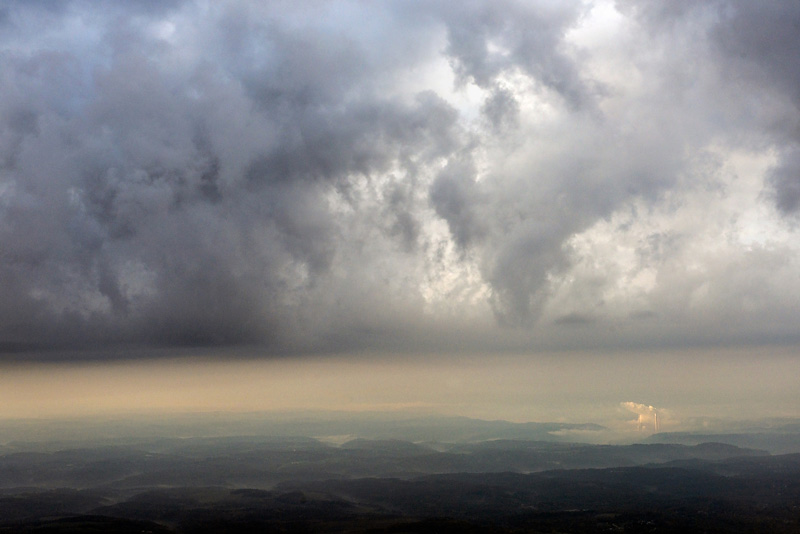
Western Pennsylvania from the air. © Scott Goldsmith/TDW 2013
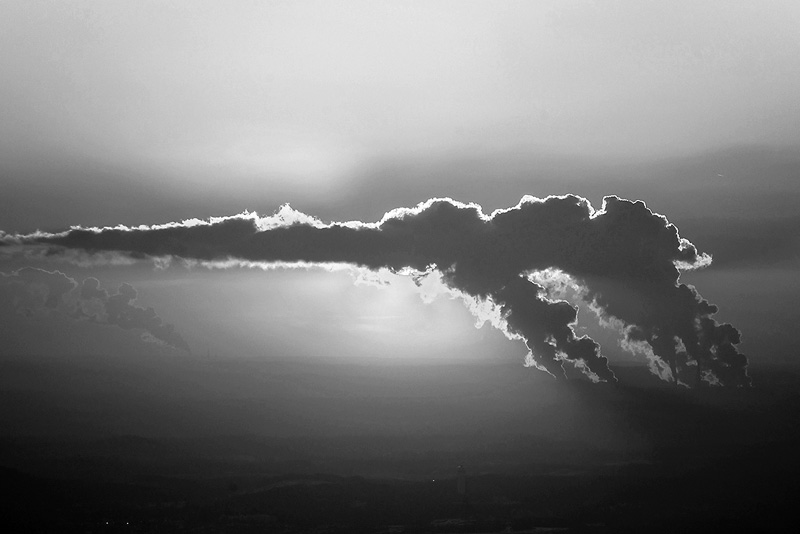
Smoke rises from a coal-fired power plant in Beaver County. © Scott Goldsmith/TDW 2014
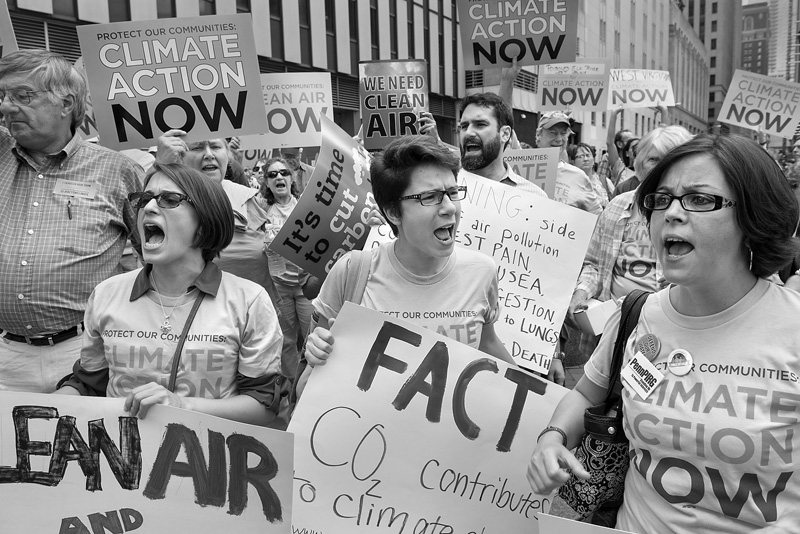
Supporters of EPA regulations against power plant carbon emissions rally in front of theAugust Wilson Center in Downtown Pittsburgh on Thursday, July 31, 2014. About 300 environmental activists yell their support for stricter pollution rules proposed by the Environmental Protection Agency during a march to the Pittsburgh Federal Building by about 5,000 people, led by the United Mine Workers of America, during a two-day public hearing being held by the EPA.. © Scott Goldsmith/TDW 2014

United Mine Worker Floyd Macheska from West Newton, PA, and his grandson Stephen Macheska, nine, from Belle Vernon, PA, watch as fourteen members of the United Mine Workers of America are arrested after refusing to move from the steps of the Federal Building. Some 5,000 union members led by the UMWA marched to protest stricter pollution rules for coal-burning power plants proposed by the EPA... © Scott Goldsmith/TDW 2014
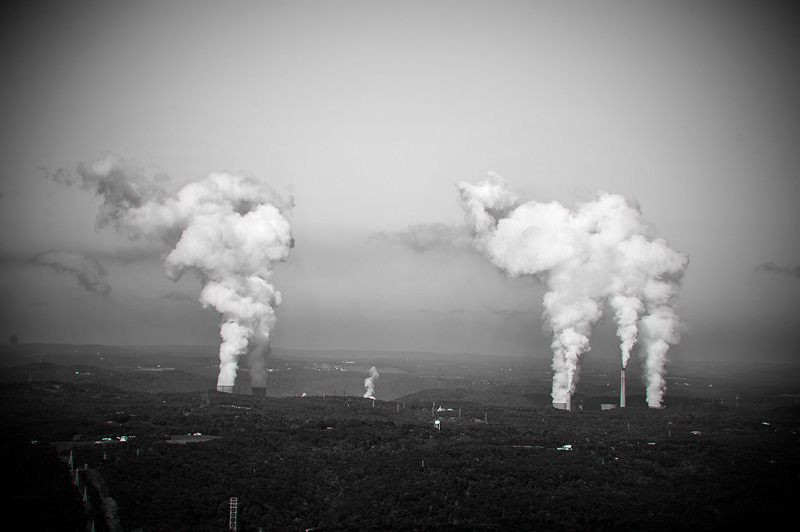
A coal-fired power plant near Shippingport, PA.. © Scott Goldsmith/TDW 2014
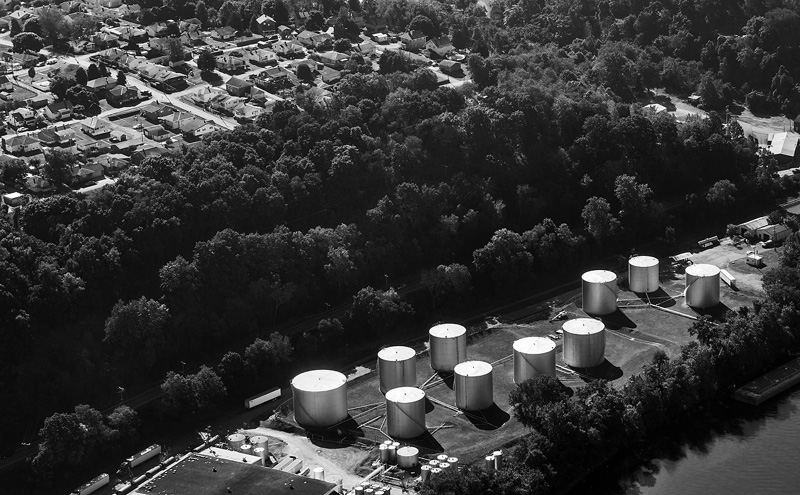
On the Ohio River just outside of Pittsburgh, PA. © Scott Goldsmith/TDW 2014

Clairton High School head coach Tom Nola addresses one of his players after a mistake during a game. Over the years, this team is regularly the best in Pennsylvania. Yet asthma is a problem known well by football players at Clairton Middle and High School, one of the smallest and poorest in the state and home to the nation’s largest coke plant, just 12 miles south of Pittsburgh. Many of the players bring inhalers to practice and games; 18.2 percent of Clairton students have asthma (national rates are 8 percent for adults and 9.3 percent for children). The football team rate is a little higher. © Scott Goldsmith/TDW 2014

Christine Pollachi breaks down during a meeting with the EPA. She was explaining her health problems caused by bad air from Shenango Inc. coke works. Emissions from coke plants include benzene and other carcinogens, hydrogen sulfide, and significant quantities of particulate matter, nitrogen oxides, and sulfur dioxide. This coke plant is less than 1 mile from the densely populated communities of Ben Avon (where Pollachi is from), Avalon, Bellevue and Emsworth — and less than 5 miles from Downtown Pittsburgh. © Scott Goldsmith/TDW 2014

A protester holds aloft a sign at a community meeting addressing air pollution in Avalon. Avalon sits six miles northwest of Pittsburgh in the shadow of the Shenango, inc. coke plant on Neville Island. © Scott Goldsmith/TDW 2014

Neville Island on a bad ozone day caused by air inversion, contamination from
Shenango Inc. coke works (smoke stack in upper middle left) and diesel engine emissions. Shenango has been the subject of numerous lawsuits and consent orders for decades. The coke works operates twenty-four hours a day, seven days a week. Asthma rates in the school district closest to Shenango are the highest in Allegheny County. The Clairton Plant can be seen on the distant horizon top right. Small flares from Shale gas rigs can be seen as tiny flames. © Scott Goldsmith/TDW 2014
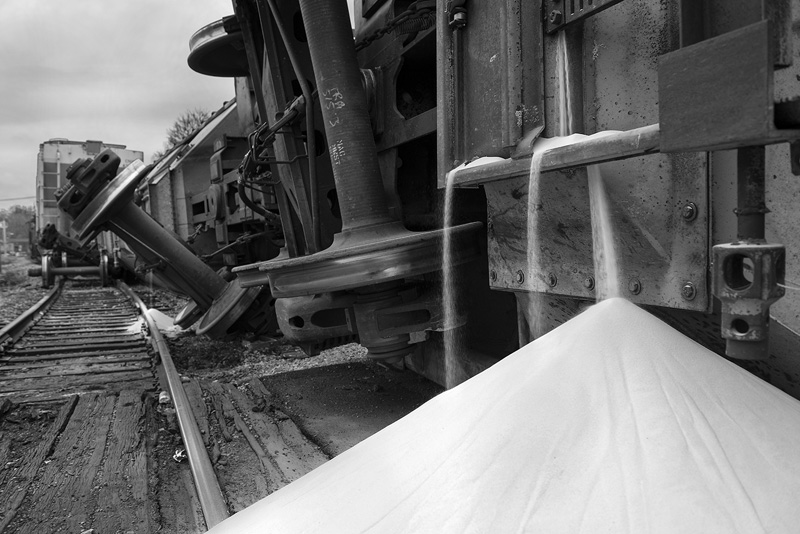
A train derailment in Uniontown, PA in 2015. One car landed 6 feet from a nearby house, spilling frack sand around it. Frack sand is used during the hydraulic fracturing process and is hazardous to human health. The particulates are so small and oddly shaped that they seldom release from the lungs and can cause many respiratory problems including lung cancer. Sand was still pouring from the train cars two hours after the accident. Residents were not warned of potential respiratory problems and the workers who cleaned it up did not wear breathing protection. © Scott Goldsmith/TDW 2015
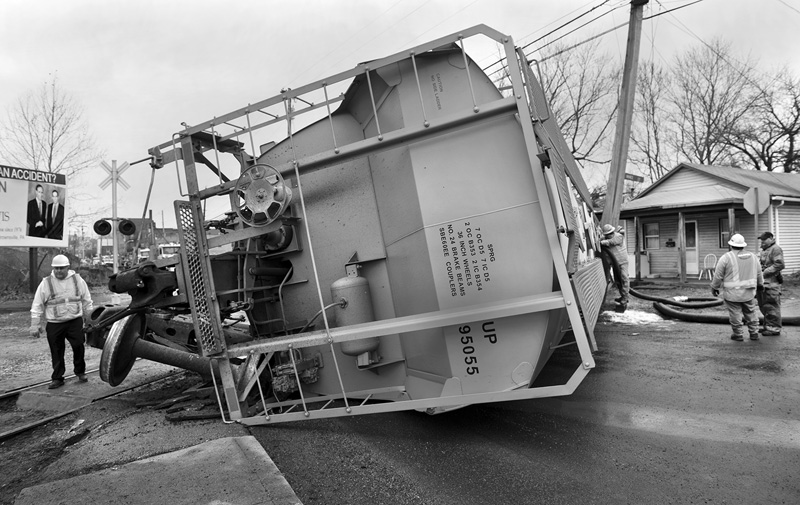
A train derailment in Uniontown, PA in 2015. One car landed 6 feet from a nearby house, spilling frack sand around it. Frack sand is used during the hydraulic fracturing process and is hazardous to human health. The particulates are so small and oddly shaped that they seldom release from the lungs and can cause many respiratory problems including lung cancer. Sand was still pouring from the train cars two hours after the accident. Residents were not warned of potential respiratory problems and the workers who cleaned it up did not wear breathing protection. © Scott Goldsmith/TDW 2015
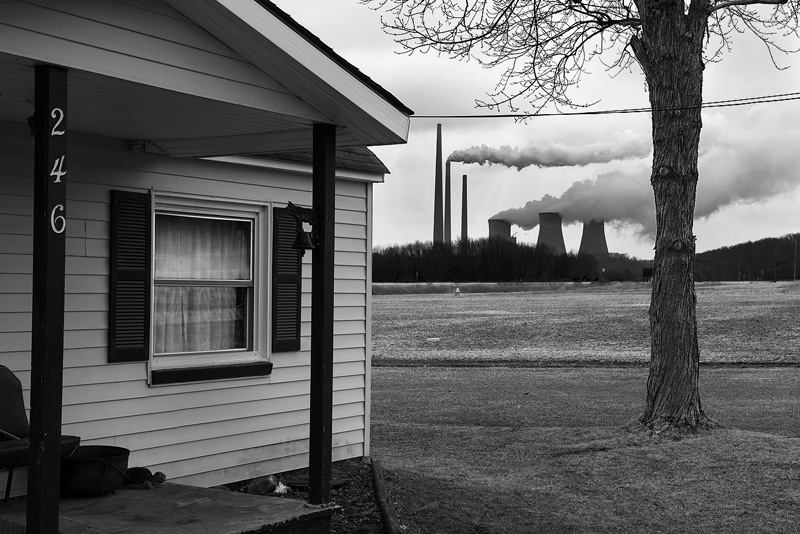
This house, in Blairsville, PA, is about a mile from the coal-fired generating plant at Homer City. Asthma rates here are high; incidence of heart ailments are higher than average. Pennsylvania’s power plants are the third most polluting in the country, and are the single largest source of carbon pollution, responsible for 48 percent of emissions statewide. © Scott Goldsmith/TDW 2015
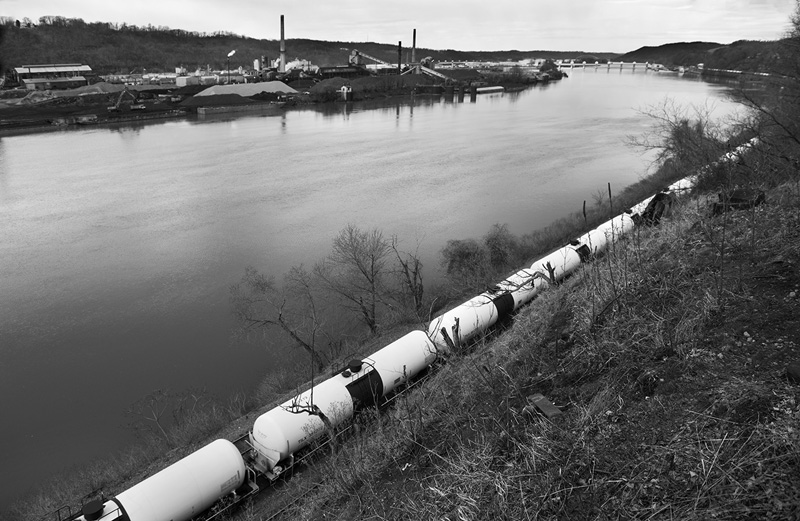
A train loaded with crude oil rolls past the Shenango Inc. coke works near Pittsburgh, PA. The U.S. Environmental Protection Agency describes coke oven emissions as “among the most toxic of all air pollutants.” The train is carrying crude oil from the Bakkan oil field in North Dakota. These trains have derailed numerous times across the U.S. causing extreme air and water pollution. The oil they carry will be burned for energy, causing further release of fine particulates. The trains themselves become air polluters along the route. © Scott Goldsmith/TDW 2015
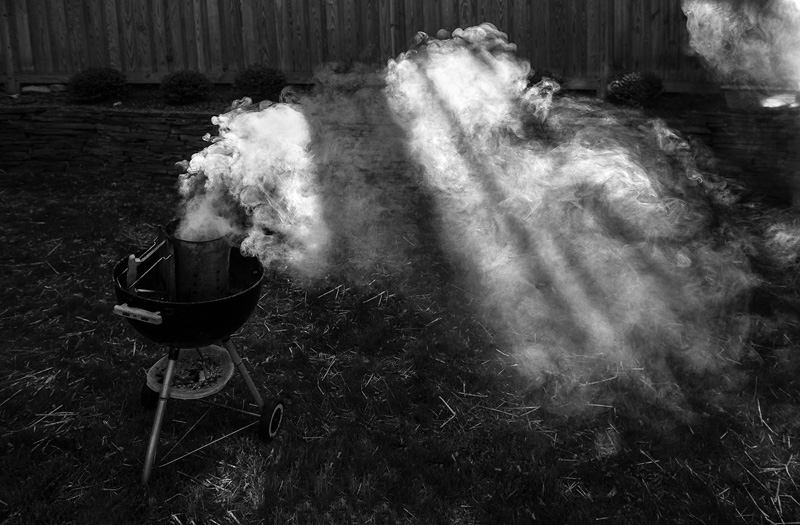
As meat grills, fat drippings hit the coals to create carcinogenic chemicals,
which are absorbed into your food and can damage your lungs. On high ozone days in western Pennsylvania, outdoor grilling exacerbates the concentration of fine particulates in the air. © Scott Goldsmith/TDW 2009

Linda Dever suffers from COPD and came to the ER at Allegheny General Hospital suffering a respiratory attack. While it is hard to pinpoint the cause of her respiratory problems, she lives close to Shenango Inc. coke works and has increased symptoms on high ozone days. The American Allergy and Asthma Foundation ranks Pittsburgh the fourth most challenging place to live with asthma in the nation, listing air pollution and the number of ozone alert days among the chief reasons why. © Scott Goldsmith/TDW 2015

Elizabeth Sandhagen lives in southern Allegheny County and must stay inside most of the time because of severe breathing problems. She uses a specialized inhaler and receives a monthly injection to keep her lung passages open. The drug—a strong antihistamine that can cause unexpected anaphylactic shock—is thick and must be administered via a large needle which causes her pain. Sandhagen’s respiratory problems dissipate significantly when she leaves
Western PA. She feels the air particulates levels in Allegheny County are the cause of her problems. © Scott Goldsmith/TDW 2015

Elizabeth Sandhagen lives in southern Allegheny County and must stay inside most of the time because of severe breathing problems. She uses a specialized inhaler and receives a monthly injection to keep her lung passages open. The drug—a strong antihistamine that can cause unexpected anaphylactic shock—is thick and must be administered via a large needle which causes her pain. Sandhagen’s respiratory problems dissipate significantly when she leaves
Western PA. She feels the air particulates levels in Allegheny County are the cause of her problems. © Scott Goldsmith/TDW 2015
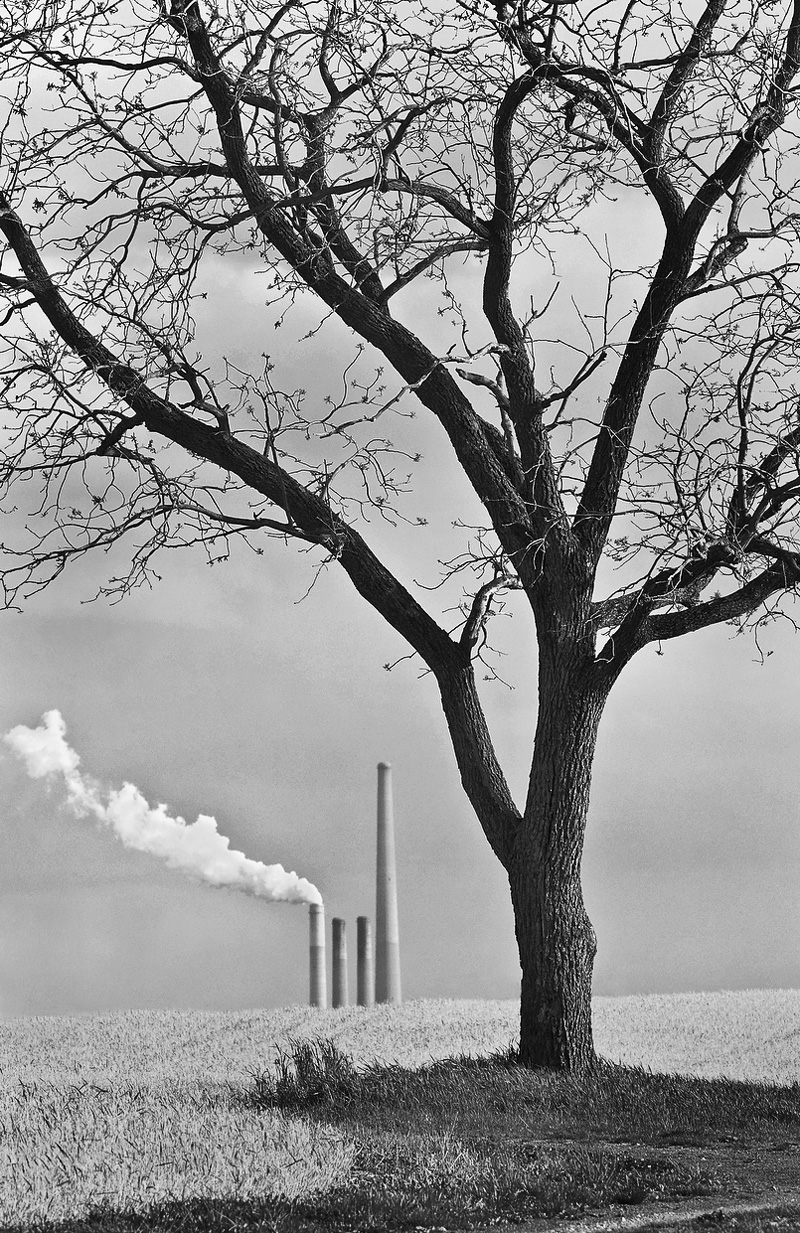
The Homer City Generating Station is one of the top five most polluting power plants in Pennsylvania, which has the third most polluting plants in the country. Pennsylvania’s power plants are its single largest source of carbon pollution—responsible for 48 percent of statewide emissions. The country’s biggest air polluters are challenging an EPA measure that would force roughly 600 coal- and oil-fired power plants to reduce the amount of mercury, arsenic, and other toxic metals and gases they let escape into the air, lakes, and rivers. © Scott Goldsmith/TDW 2015
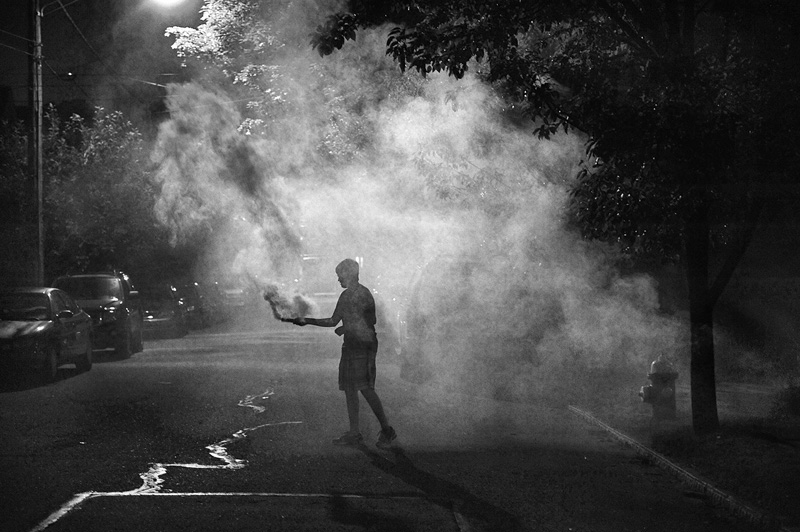
A boy playing with fireworks in the Bellevue borough of Pittsburgh. A new NOAA study shows that Fourth of July fireworks temporarily increase particulate pollution by an average of 42 percent. The effect is worse in the Pittsburgh area because of trapped air due to inversions. © Scott Goldsmith/TDW 2009





















Fog, smoke, and air inversion often create a perfect setting for bad air quality along the Ohio River near the Shenango Inc. coke works. Residents living nearby have the highest rates of asthma in Allegheny County. Coke oven fuel made from coal emits various toxins along with odors and smoke. Pittsburgh has some of the worst fine-particle pollution in the nation, due in part to the presence of several coke plants in close proximity. © Scott Goldsmith/TDW 2004
Western Pennsylvania from the air. © Scott Goldsmith/TDW 2013
Smoke rises from a coal-fired power plant in Beaver County. © Scott Goldsmith/TDW 2014
Supporters of EPA regulations against power plant carbon emissions rally in front of theAugust Wilson Center in Downtown Pittsburgh on Thursday, July 31, 2014. About 300 environmental activists yell their support for stricter pollution rules proposed by the Environmental Protection Agency during a march to the Pittsburgh Federal Building by about 5,000 people, led by the United Mine Workers of America, during a two-day public hearing being held by the EPA.. © Scott Goldsmith/TDW 2014
United Mine Worker Floyd Macheska from West Newton, PA, and his grandson Stephen Macheska, nine, from Belle Vernon, PA, watch as fourteen members of the United Mine Workers of America are arrested after refusing to move from the steps of the Federal Building. Some 5,000 union members led by the UMWA marched to protest stricter pollution rules for coal-burning power plants proposed by the EPA... © Scott Goldsmith/TDW 2014
A coal-fired power plant near Shippingport, PA.. © Scott Goldsmith/TDW 2014
On the Ohio River just outside of Pittsburgh, PA. © Scott Goldsmith/TDW 2014
Clairton High School head coach Tom Nola addresses one of his players after a mistake during a game. Over the years, this team is regularly the best in Pennsylvania. Yet asthma is a problem known well by football players at Clairton Middle and High School, one of the smallest and poorest in the state and home to the nation’s largest coke plant, just 12 miles south of Pittsburgh. Many of the players bring inhalers to practice and games; 18.2 percent of Clairton students have asthma (national rates are 8 percent for adults and 9.3 percent for children). The football team rate is a little higher. © Scott Goldsmith/TDW 2014
Christine Pollachi breaks down during a meeting with the EPA. She was explaining her health problems caused by bad air from Shenango Inc. coke works. Emissions from coke plants include benzene and other carcinogens, hydrogen sulfide, and significant quantities of particulate matter, nitrogen oxides, and sulfur dioxide. This coke plant is less than 1 mile from the densely populated communities of Ben Avon (where Pollachi is from), Avalon, Bellevue and Emsworth — and less than 5 miles from Downtown Pittsburgh. © Scott Goldsmith/TDW 2014
A protester holds aloft a sign at a community meeting addressing air pollution in Avalon. Avalon sits six miles northwest of Pittsburgh in the shadow of the Shenango, inc. coke plant on Neville Island. © Scott Goldsmith/TDW 2014
Neville Island on a bad ozone day caused by air inversion, contamination from
Shenango Inc. coke works (smoke stack in upper middle left) and diesel engine emissions. Shenango has been the subject of numerous lawsuits and consent orders for decades. The coke works operates twenty-four hours a day, seven days a week. Asthma rates in the school district closest to Shenango are the highest in Allegheny County. The Clairton Plant can be seen on the distant horizon top right. Small flares from Shale gas rigs can be seen as tiny flames. © Scott Goldsmith/TDW 2014
A train derailment in Uniontown, PA in 2015. One car landed 6 feet from a nearby house, spilling frack sand around it. Frack sand is used during the hydraulic fracturing process and is hazardous to human health. The particulates are so small and oddly shaped that they seldom release from the lungs and can cause many respiratory problems including lung cancer. Sand was still pouring from the train cars two hours after the accident. Residents were not warned of potential respiratory problems and the workers who cleaned it up did not wear breathing protection. © Scott Goldsmith/TDW 2015
A train derailment in Uniontown, PA in 2015. One car landed 6 feet from a nearby house, spilling frack sand around it. Frack sand is used during the hydraulic fracturing process and is hazardous to human health. The particulates are so small and oddly shaped that they seldom release from the lungs and can cause many respiratory problems including lung cancer. Sand was still pouring from the train cars two hours after the accident. Residents were not warned of potential respiratory problems and the workers who cleaned it up did not wear breathing protection. © Scott Goldsmith/TDW 2015
This house, in Blairsville, PA, is about a mile from the coal-fired generating plant at Homer City. Asthma rates here are high; incidence of heart ailments are higher than average. Pennsylvania’s power plants are the third most polluting in the country, and are the single largest source of carbon pollution, responsible for 48 percent of emissions statewide. © Scott Goldsmith/TDW 2015
A train loaded with crude oil rolls past the Shenango Inc. coke works near Pittsburgh, PA. The U.S. Environmental Protection Agency describes coke oven emissions as “among the most toxic of all air pollutants.” The train is carrying crude oil from the Bakkan oil field in North Dakota. These trains have derailed numerous times across the U.S. causing extreme air and water pollution. The oil they carry will be burned for energy, causing further release of fine particulates. The trains themselves become air polluters along the route. © Scott Goldsmith/TDW 2015
As meat grills, fat drippings hit the coals to create carcinogenic chemicals,
which are absorbed into your food and can damage your lungs. On high ozone days in western Pennsylvania, outdoor grilling exacerbates the concentration of fine particulates in the air. © Scott Goldsmith/TDW 2009
Linda Dever suffers from COPD and came to the ER at Allegheny General Hospital suffering a respiratory attack. While it is hard to pinpoint the cause of her respiratory problems, she lives close to Shenango Inc. coke works and has increased symptoms on high ozone days. The American Allergy and Asthma Foundation ranks Pittsburgh the fourth most challenging place to live with asthma in the nation, listing air pollution and the number of ozone alert days among the chief reasons why. © Scott Goldsmith/TDW 2015
Elizabeth Sandhagen lives in southern Allegheny County and must stay inside most of the time because of severe breathing problems. She uses a specialized inhaler and receives a monthly injection to keep her lung passages open. The drug—a strong antihistamine that can cause unexpected anaphylactic shock—is thick and must be administered via a large needle which causes her pain. Sandhagen’s respiratory problems dissipate significantly when she leaves
Western PA. She feels the air particulates levels in Allegheny County are the cause of her problems. © Scott Goldsmith/TDW 2015
Elizabeth Sandhagen lives in southern Allegheny County and must stay inside most of the time because of severe breathing problems. She uses a specialized inhaler and receives a monthly injection to keep her lung passages open. The drug—a strong antihistamine that can cause unexpected anaphylactic shock—is thick and must be administered via a large needle which causes her pain. Sandhagen’s respiratory problems dissipate significantly when she leaves
Western PA. She feels the air particulates levels in Allegheny County are the cause of her problems. © Scott Goldsmith/TDW 2015
The Homer City Generating Station is one of the top five most polluting power plants in Pennsylvania, which has the third most polluting plants in the country. Pennsylvania’s power plants are its single largest source of carbon pollution—responsible for 48 percent of statewide emissions. The country’s biggest air polluters are challenging an EPA measure that would force roughly 600 coal- and oil-fired power plants to reduce the amount of mercury, arsenic, and other toxic metals and gases they let escape into the air, lakes, and rivers. © Scott Goldsmith/TDW 2015
A boy playing with fireworks in the Bellevue borough of Pittsburgh. A new NOAA study shows that Fourth of July fireworks temporarily increase particulate pollution by an average of 42 percent. The effect is worse in the Pittsburgh area because of trapped air due to inversions. © Scott Goldsmith/TDW 2009
